Category: 9:30 AM Class
Extra Credit
For my extra credit assignment I attended an art related event on campus. The event was located in the Brooklyn College Library near the front entrance hosted by Dr. Jean Eddy Saint Paul the founding director of CUNY Haitian Studies Institute and Professor of Sociology. The art exhibit was called Beyond Vertieres which contained art works because of French historiography and the history of Haitians. The art works were based on the events that happened during the Battle of Vertieres on November 18, 1803 between the Indigenous Army of Saint Domingue (Haiti) and the French Expeditionary Army of Napoleon Bonaparte. The Battle of Vetrieres resulted in the Haitians defeating the French because they fought for their freedom and would not allow white supremacy to take over the black race. The Haitian people were determined to fight for what was right and would not have their freedom taken away from them. They were unflinching, undaunted, and united to abolish slavery and challenge the French, through their self-sacrifice and tenacity they fought for the respect for human dignity and a decolonial racial justice.
In the beginning of the exhibit it asks “Why, even today, after 215 years, are Haitian citizens unable to access a dignified life?” and “What are we to do beyond Vertieres?” The exhibit then explains and invites the viewer “to re-appropriate/ embrace the core values of freedom, justice, and equality that made Vertieres possible in order to rethink a new system compatible to an emancipated citizenship” The exhibit then expresses through all the art works that represent freedom and the struggles of the battle. The first two pieces was the Pourqoui Vertieres and L’enfant Restavek: Pourquoi Vertieres by Tara Boirad which was created in 2018, it was an acrylic of a small child in each of the art works. In the Pourqoui Vertieres it was a little boy and in L’enfant Restavek: Pourquoi Vertieres it was a little girl both of them seem to have a blank expression and the artworks were both close up images of their faces in black and white. In the next three pieces created by Patricia Brintle were Catherine Flon (2011), Defille la folle (2008), and Marie Jeanne Lamartiniere (2012), in the three pieces it depicted hard working women transitioning from sewing clothes and washing it to holding up a flag and in the midst of battle, there was more color and you could see the contrast in the colors form bright to dark, the colors in each of the works were similar but used in different places.
There were many works of art shown in the exhibit which showed and represented the Haitian culture traditions and their struggles. Their struggles and stakes have been conveyed through these artworks by showing what they had to risk for the sake of freedom and it showed the importance of remembering the history of the Battle of Vertieres and what all those men and women fought for by putting their lives on the line. The event contained many wonderful pieces and works of art, from abstract pieces to spiritual and human expression, overall I enjoyed the exhibit and would like to stop by the library to see all of the art works again.





Final Project – Walking Tour
Hello, and welcome to my tour. My name is Perel, but you can call me Perri. Today we will be talking about Egyptian art and the use of Hieroglyphics/hieroglyphs within them. Hieroglyphics was the written language of Ancient Egypt. “It was in form of objects–animals, plants, and household items–that the ancient Egyptians saw around them every day.” (Teeter) 
The second piece of ancient Egyptian hieroglyphics that we’ll look at is papyrus and the hieroglyphics written on it. Papyrus is a plant that was used for a number of objects, but the most important us was as a “writing surface” for things like “household and administrative documents, letters, contracts and other legal texts, illustrated narratives, and religious texts.”
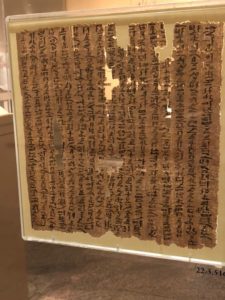 This piece of papyrus has hieroglyphics on it since that was the only form of writing that was available. There are more than 800 used hieroglyphics, but the most common are the twenty-four that are used to sound out words (like the English letters).
This piece of papyrus has hieroglyphics on it since that was the only form of writing that was available. There are more than 800 used hieroglyphics, but the most common are the twenty-four that are used to sound out words (like the English letters).
 Next we are going to look at the amulets. These were put on jewelry, put around the house to beautify the dwelling, or buried with a mummy to have positive energy. Many Egyptians carried them around as a form of good luck and to bring positive energy. Some of the amulets had writing on it, hieroglyphics, to write exactly what energy they wanted the amulets to bring them. They were the perfect thing to carry around because of their size, they were convenient.
Next we are going to look at the amulets. These were put on jewelry, put around the house to beautify the dwelling, or buried with a mummy to have positive energy. Many Egyptians carried them around as a form of good luck and to bring positive energy. Some of the amulets had writing on it, hieroglyphics, to write exactly what energy they wanted the amulets to bring them. They were the perfect thing to carry around because of their size, they were convenient.
 The next thing we’ll look at is “Mummy Mask of a Woman with a Jeweled Garland”. THis was a mask placed over the mummy before it was placed in the tomb. There are paintings all around it to tell the story of the person in the mummy, to bring good energy to the persons transition to the afterlife, and to beautify the mummy so that the person is honored. Within the beautiful painting there are hieroglyphics. This is done to explain some of the painting, to give some positive words, and to identify the person within the mummy.
The next thing we’ll look at is “Mummy Mask of a Woman with a Jeweled Garland”. THis was a mask placed over the mummy before it was placed in the tomb. There are paintings all around it to tell the story of the person in the mummy, to bring good energy to the persons transition to the afterlife, and to beautify the mummy so that the person is honored. Within the beautiful painting there are hieroglyphics. This is done to explain some of the painting, to give some positive words, and to identify the person within the mummy.
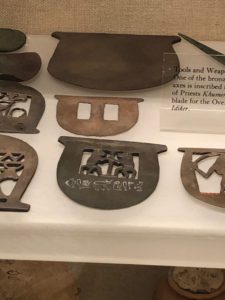 The last piece we are going to look at are these weapons. These were used by the Egyptians in battle. The curved edge was sharp and was a knife to fight the enemies. The hieroglyphics were engraved onto these items to give the fighter good luck in battle, and to mark who’s weapon is whoms. Each hieroglyph can be an entire word so even though there are about ten hieroglyphics on the piece it could say numerous things.
The last piece we are going to look at are these weapons. These were used by the Egyptians in battle. The curved edge was sharp and was a knife to fight the enemies. The hieroglyphics were engraved onto these items to give the fighter good luck in battle, and to mark who’s weapon is whoms. Each hieroglyph can be an entire word so even though there are about ten hieroglyphics on the piece it could say numerous things.
This tour was designed to show the different ways in which hieroglyphics were used and the different objects it was used on and I hope I accomplished that.
- Kamrin, Janice. “Papyrus in Ancient Egypt.” In Heilbrunn Timeline of Art History. New York: The Metropolitan Museum of Art, 2000–. http://www.metmuseum.org/toah/hd/papy/hd_papy.htm (March 2015)
- Patch, Diana Craig. “Egyptian Amulets.” In Heilbrunn Timeline of Art History. New York: The Metropolitan Museum of Art, 2000–. http://www.metmuseum.org/toah/hd/egam/hd_egam.htm (October 2004)
- “Rosetta Stone.” Britannica Online Academic Edition, 2018, pp. Encyclopædia Britannica, Inc.
- Teeter, Emily. “Egyptian Hieroglyphs.” Calliope, vol. 14, no. 9, 2004, pp. 7–10.
- The British Museum, “Paintings from the Tomb-chapel of Nebamun,” in Smarthistory, August 29, 2016, accessed December 12, 2018, https://smarthistory.org/paintings-from-the-tomb-chapel-of-nebamun/.
Annotated Bibliography; (Extracted from another post, I forgot to post the bib as a separate post)
(I forgot to post the annotated bibliography as a separate post and left it in my previous post which combined both the final project and the annotated bibliography, I’m very sorry!)
Bibliography: Museum Sites
- “The Lamentation.” The Met’s Heilbrunn Timeline of Art History, www.metmuseum.org/toah/works-of-art/2008.72/; accessed December 17, 2018, https://www.metmuseum.org/toah/works-of-art/2008.72/
This link is coming directly from The Met website and gives a brief catalogue description of The Lamentation. I will incorporate this into my final project by paraphrasing their descriptional analyses and keywords so I can easily distinguish features between Renaissance and Baroque art.
- “Saint Maurice.” The Met’s Heilbrunn Timeline of Art History, www.metmuseum.org/exhibitions/listings/2015/cranach-saint-maurice.
This link is also taken directly from The Met website. In the site, the author explains the significance of the exhibition which involved other works of art that were painted/made during the same time period and location. This allowed me to analyze the distinguishing features of the time and apply it to Saint Maurice. The website also had a YouTube video which helped me analyze the portrait even more.
- “Departure of the Amazons.” The Met’s Heilbrunn Timeline of Art History, https://www.metmuseum.org/toah/works-of-art/1976.100.6/; accessed December 16, 2018.
There was no specific museum site that helped me understand this painting. Instead, I used the generic Met catalogue description of the painting. It gave me the basic information I needed, such as the dimensions, the medium, the historical and political background, and the artist who painted it. It also listed some features I incorporated into my final project and used it to compare and contrast styles between this painting and other paintings.
Bibliography: Magazines/Journals/Articles
This is an extensive pdf article of The Merry Company on a Terrace. It was a really helpful addition to my final project because it nicely explained the background/history of the painter (Jan Steen) and why he incorporated himself into his own painting. In addition to that, the article also analyzes every single character in the painting in depth. One theme the author of the article focused on was the emotional intensity of the painting. This is one feature I incorporated into my final project and it was also a useful addition to the list of differences between Renaissance and Baroque art.
This article layed out a detailed formal analysis of The Lamentation. Although the painting was different from the one in The Met, it provided me with more background historical details I did not comprehend at first. I only payed attention to the theme of the entire painting because there are many different alterations of this painting and most of them share a similar theme.
Themed Museum Tour: Final Project
 Loading...
Loading...
Final Project
THESIS:
Although women and feminism are sometimes overlooked in the discussion of Egyptian art, The presence of Feminism and women in Ancient Egyptian culture is not only reflected in Egyptian art, but adds an entire new layer of importance, depth and value to the artwork.
STATEMENT ONE:
Feminism was subtle integrated in the fashion of the men in Ancient Egypt, showing their respect and need for feminism in their own everyday lives.
- Egyptian clothing was about class. The clothes that everyone wore reflected which social class they belonged to and the status that they held in society
- The basic attire for All men in Ancient Egyptian society was a wrap skirt around their waist,because it was fashionable (Fun fact :the color of the skirts were preferably white to reflect cleanliness)
- Depending on how rich a man was, their skirts would be decorated with various amount of expensive jewelry and beads.
- The clothes were mostly made by women – this meaning that behind the scenes, women dictated what looked fashionable and therefore played a enormous role in the unique appearances of ancient egypt
- Men (including the Pharaohs) also wore makeup to darken their eyes
- To conclude the various integrations of femininity into the men’s fashion wear in Ancient Egypt ( jewelry, skirts, beads, makeup) showed that men valued the balance of masculinity and femininity. The combination of both was seen as a sign of strength, status, and appealing to the gods.
- The presence of femininity in egyptian fashion reflected a major Egyptian value as well. ““One of the central values of ancient Egyptian civilization, arguably the central value, was ma’at – the concept of harmony and balance in all aspects of one’s life”
- Take the painting below for example Depicts the process of Egyptian Afterlife
- The men are all wearing skirts or dress – not one pair of pants is in sight
- Each male present has an adornment of some sort, whether it be jewelry or extra fabric, which signifies their individual role and power in their Human life.
- Each males as well can be seen wearing eyeliner.
- All of the men present in this painting ( with the exception of the scribe) are gods. They are looked up to and respected by everyone living in Egypt. However even the Gods of ancient egypt cannot deny the need for femininity and balance in their everyday lives, as depicted in the painting.
SOURCES
- https://www.historyonthenet.com/egyptian-clothing
- https://www.ancient.eu/article/623/women-in-ancient-egypt/
STATEMENT TWO:
Women’s role in everyday life was essential to the society functioning as well as it did. These depictions of women in action through ancient egyptian art are necessary to show that ancient Egypt didn’t just consist of the conquering of other nations and how strong the pharaoh or any man’s masculinity was. On the other hand it displayed just how strong the women were as well
- Women were mainly in charge of the household duties ( cooking and cleaning, raising the children) while men were in charge of going to war and handling“ affairs of the state” In terms of social status however, the roles of both genders combined displayed what was valued in the social scale for Ancient Egypt. Long story short, to be viewed as a wholesome balanced family in ancient Egypt you can’t have one without the other.
- Women has the same rights under the law as men.
- Women handled their own individual property
- Woman decided who they wanted to marry and also decided if they wanted divorces or not.
- Women were also goddesses, One goddess that we can mention is Bastet. This goddess specifically looked out for the good of women and protected all the affairs of women
- Women were also priest who could interpret dreams (Dream’s were very important on the religious scale) dreams were considered to be portals to the after life.
- Take the statue below for example
-
- It promotes the equality between both the male and the female in the family
- If you look even closer the man is leaning back and the woman is holding up
- In other words, she is so much more than just his support system, she is an equal, she is strong and powerful. Without her he wouldn’t survive.
SOURCES
- https://www.ancient.eu/article/623/women-in-ancient-egypt/
- https://www.ancient.eu/Bastet/
STATEMENT THREE
There were many queens in ancient Egyptian history, but Queen Nefertiti is the the default queen that most people refer to. The reason being she as a queen arguably contributed more to ancient Egypt legacy than some other kings and pharaohs.
- – Nefertiti, whose name means “a beautiful woman has come,”
- She ruled alongside her husband Akhenaten, and made decisions for the well being of Egypt
- She and her husband started the religious revolution in creating the Atens clan.
The carving below displays Nefetari alongside her husband with their children.
-As stated before they are equals
– She Is seated on the throne alongside her husband. This suggesting that no decision can be made without her.
( Scroll Down)
(Below is the Pdf document with the pictures. )
 Loading...
Loading...
Themed Museum Tour- Final Project
Rachel Swed
Art 1010
Professor Shaw
Evolution of Art
Art has been the center of many great civilizations. We see this all the way from the Egyptian art till today. Art has changed greatly over time but its ability to portray emotion or tell a story has remained. Art has become the center of human creativity and has existed for thousands of years. But what impacted artist from civilization to civilization and how did art evolve into what it is today?

In ancient Egypt, art was used to teach or portray a story, mainly for religious teachings and common rituals. Examples of this can be the numerous painting, sculptures, and pieces of gods, pharaohs, and death masks. One example from the Brooklyn Museum is The Head of a Queen, which is dated back to 1400 BCE. As we discussed in class, ancient civilizations loved making art pieces that depicted their rulers to demonstrate their power and reverence. This artwork was chosen because it’s a great example to show how prominent the kingdom was in Egypt. Religion has played a major key in the arts successes from music to paintings particularly in this civilization.
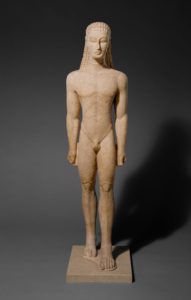
Contrarily, when looking at Greek and Roman art it incorporates humanism. Humanism’s main focus is on mankind, rather than divine or godlike matters. When looking at Greek and Roman art, we see large human sculptures like Kouros seen at the MET. This is a great example because the face, stomach, and legs of this sculpture are polished, glowing, and realistic, making it almost human. The sculpture also has robbed curls on its head, characteristic of Greek/Roman culture. The sculpture is standing on an angle, as if in motion making the figure seem alive. The nudity in this sculpture is a very common characteristic in Greek/Roman sculptures and painting which dates from the ancient time, continued during the whole timeline of art, was the presentation of their culture in everyday life. This shows how their cultures and confrontation with everyday life was shown in their artworks.

As we move out of ancient world arts and into a closer century, during the 19th century we see a slight shift to a different style of painting- landscape paintings which were very popular. Landscape paintings depicted the intense beauty of nature through the eyes of the artist. One famous artist Vincent van Gogh and his most prized work Starry Night seen at the MOMA is a great example of landscape art which is why I choose to use it. One major movement during this time was the Romantic movement which greatly popularized the interest of landscape art. Different art techniques were used and referred to as Impressionism and Post-Impressionism. Impressions strayed away from story-telling in their artworks and instead focused on drawing everyday life. Light and color were very important aspects in impressionist paintings.

In the 20th century, we still see movements affecting painting- one powerful one to begin with- the rights of colored people. This shows how art can be about what’s going on in society. The exhibit, soul of the nation has many artworks expressing the oppression faced by people of color. The artwork, Did The Bear Sit Under a Tree, by Benny Andrews, is a great example of the movement affecting blacks which is why I chose it. The painting caught my attention because of its honesty and rawness are seen by the aggressiveness of the lines and oil paint used. Furthermore, the rough texture symbolized the place he came from. From where he came, everything was rough – from the fabrics people used to the clothes they wore. That is why he chose to use a rough texture. The man in the painting looks like he is rolling away the American flag. His firmly straight face and fisted hand give him an angry appearance. The caption next to the picture states that this painting is a representation of a colored man during the civil rights movement “shaking his fist” at the flag which was supposed to protect him. In conclusion, I think that the painting successfully conveys the painter’s message. It clearly illustrates that the man is not happy with how the United States is treating colored people. This shows how art was used to portray what is affecting the people in the civilization.
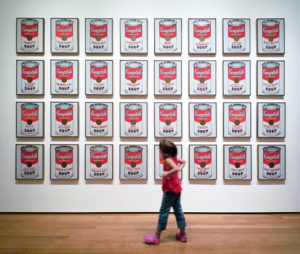
Lastly, when moving into the 20th century we see what is prominent in this century- consumer culture and mass media. This was seen through the new art movement- pop art. Andy Warhol “Campbell’s Soup Cans” is a prime example of this because it shows the mass produced product and it was advertised everywhere- so much so that Warhol used to drink it every day for 20 years! This thirty-two canvas painting represents the thirty-two soup flavors which were displayed on shelves together to look like grocery aisles at first. The bases of this kind of modern art is taking something which is not initially seen as art and makes us think about it in a different way. This art shows what was important then and now-mass production- and how it affected artworks of the 20th century.
Art has transformed over time to become even more complex, and its interpretations have changed as well. Today, good artworks give a different meaning to each individual person. Art can tell a story, depict a beautiful scene of nature, or convey humor. Art does not have to be specific or follow certain guidelines compared to art in the middle ages. If it weren’t to the inspiring individuals who shaped the development of art today, the diversity of artworks we have today wouldn’t exist. From movies to marketing and advertising, modern art is becoming more involved digitally while maintaining the physical beauty of what art is. Art shapes identities and impacts our society as a whole. Art helps creativity thrive and with the constant negativity in our continuing fast developing society, we need to embrace and support art now more than ever. Overall, we see how art changed from civilization to civilization based on what was prominent or important at that time. From ancient Egyptian which religion primed them to make their pieces to modern art where movements and mass media was a huge part of civilizations and impacted what was seen in the art at that time.
Work Cited Page:
Dr. Beth Harris and Dr. Steven Zucker, “Marble statue of a kouros (New York Kouros),” in Smarthistory, December 20, 2015, accessed December 9, 2018, https://smarthistory.org/marble-statue-of-a-kouros-new-york-kouros/.
Dr. Noelle Paulson “Vincent Van Gogh, The Starry Night.” Smarthistory, accessed December 14, 2018, smarthistory.org/van-gogh-the-starry-night/.
Gisela M. A. Richter. “The Greek Kouros in the Metropolitan Museum of Art.” The Journal of Hellenic Studies, vol. 53, 1933, pp. 51–53. JSTOR, JSTOR, www.jstor.org/stable/627245.
“MoMA Learning.” Lee Bontecou. Campbell’s Soup Cans. 1959 | MoMA, www.moma.org/learn/moma_learning/andy-warhol-campbells-soup-cans-1962/.
“The Fascinating Story behind Andy Warhol’s Soup Cans | Art | Agenda.” Phaidon, www.phaidon.com/agenda/art/articles/2013/february/22/the-fascinating-story-behind-andy-warhols-soup-cans
Part B-Annotated Bibliography- Final Project
Bibliography: Museum Sites
- Dr. Beth Harris and Dr. Steven Zucker, “Marble statue of a kouros (New York Kouros),” in Smarthistory, December 20, 2015, accessed December 9, 2018, https://smarthistory.org/marble-statue-of-a-kouros-new-york-kouros/.
This is useful because it provides two videos that go into detail about the statue Kouros and how it was made based on Greek and Roman Culture. It goes into each feature of the sculpture and what it represents. This is helpful for my project because it offers descriptions on the kouros and what the body represents. This is related to my project of how art evolved when I talk about art in the ancient Greek world.
2. Dr. Noelle Paulson “Vincent Van Gogh, The Starry Night.” Smarthistory, accessed December 14, 2018, smarthistory.org/van-gogh-the-starry-night/.
This link is useful because it talks about the details of this famous painting by Van Gogh including: the landscape, challenges, and the location. It even goes more in-depth with the colors of the sky. Overall, it does a great formal analysis of the painting extremely useful for my final project.
- “MoMA Learning.” Lee Bontecou. Campell’s Soup Cans. 1959 | MoMA, accessed December 14, 2018, www.moma.org/learn/moma_learning/andy-warhol-campbells-soup-cans-1962/.
This talk about the time period in which the painting was made and details about the painting that are not made known which I find useful to my project to connect it to other time periods.
Bibliography: Magazines/articles/journals:
- “The Fascinating Story behind Andy Warhol’s Soup Cans | Art | Agenda.” Phaidon, www.phaidon.com/agenda/art/articles/2013/february/22/the-fascinating-story-behind-andy-warhols-soup-cans/.
This article published by Phaidon is useful because it gave me insight about why Warhol painting the “Campbell’s Soup Cans.” It also talks about the paintings itself and how it was displayed and how he painted it. This is related to my project when I talk about modern-day art and how its way different than the art of the ancient world.
- Gisela M. A. Richter. “The Greek Kouros in the Metropolitan Museum of Art.” The Journal of Hellenic Studies, vol. 53, 1933, pp. 51–53. JSTOR, JSTOR, www.jstor.org/stable/627245.
This journal article written by Gisela M. A. Richter is about the Kouros at The Metropolitan Museum. This article provides the significance of the statue of Kouros as well as information on the preservation of the Kouros and how it made its way into The Metropolitan Museum. This article is useful because it provides information on the Kouros and what the human body symbolizes in the statue. This is related to my project of how art evolved when I talk about art in the ancient Greek world.

Extra Credit- “Jewelry: The Body Transformed” at the MET
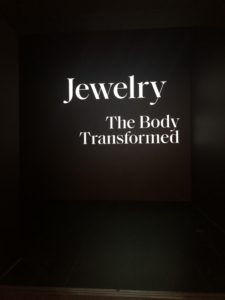

On Monday, November 19, 2018, I went to the Metropolitan Museum of Art to check out their new exhibition called “Jewelry: The Body Transformed.” The room was dim with black painted walls with glass columns from the ceiling to the floor with a piece of jewelry inside. This exhibition is all about jewelry, why wear it, and what its meaning is throughout history. They had 5 areas themed for something else such as the divine body, the regal body, the transcendent body, the alluring body, and the resplendent body. It wasn’t necessarily organized by time, but by theme, which was nice for a change. Jewelry is known to be an ancient form art that has enhanced and embellished the human body. Each area had to do what jewelry was attributed to. From the earliest time, it was attributed to the gods. Eventually, it was something that became appealing to the eye and became like a piece of clothing. Throughout history, jewelry has been something that helped others understand the culture of that time. I recognized the names of famous designers of some of the pieces such as Swarovski and Cartier.

The Seductive Pearl
Five strand pearl necklace
Cartier (French, founded in 1847)
Made in London, ca. 1926
The piece that stuck out to me most had to be the pearl necklace from the Alluring body area. Pearls are my favorite type of jewelry. Also, the company Cartier stuck out to me. Pearls in history were known to be as an erotic accessory. This idea faded in the era of post World War 2.
This exhibition is my by far my favorite that I ever went to. It was interesting to learn about the meaning of pieces of jewelry in different eras. It gave me the opportunity to learn about cultures were like and comparing it to what it’s like nowadays. I never looked at it as a form of art until I went to this exhibition. I now look at jewelry as something that unites body and art. Overall, I had an enjoyable time looking at the beautiful pieces at this exhibition.
Final Project (Museum Tour)
Cassandra Moseley
Professor Shaw
Art 1010
Humanism became prominent in the Ancient worlds of Greece and Rome, which are very intertwined with one another. Humanism revolves around the Beauty of the Human form and its Essence. Humanism during the Greek and Roman era of artwork put humans at the center of everything; the human experience is at the center of all events in contrast to previous societies that put God at the center of everything. As time proceeds we begin to see an evolution of Humanism in which different elements begin to enhance this concept, most of which is seen through statues of men and women that were either prominent figures or part of mythology. Though, the evolution of Humanism can be seen through the different works of art that depict children during these Ancient times. Today, I will take you on a museum tour to explore the theme of children being depicted in artwork and their clear demonstration of the evolution of Humanism throughout the Ancient Worlds. We will begin the tour starting with Ancient Egypt.

This first image is Statue of Queen Ankhnes-myre II and her son, Pepy II, ca 2288-2224 or 2194 B.C.E., at the Brooklyn Museum. I am beginning this tour with this piece of artwork from the Old Kingdom of Ancient Egypt. During this time, artwork still revolved around the different Egyptian Gods meaning that humans were not considered to be at the center of the universe at this point. I chose to begin with this particular piece because it is one of the first, and few times we see a child in artwork. In beginning the tour with this piece we can see that the child does not phenotypically display accurate representations of what children look/looked like. The child does not have any characteristic child features that would instantaneously make us assume that this was in fact a child. In the way the child was made to look in this piece, he just looks like a smaller version of an adult, again because he lacks resemblance to children. This piece of work is good to keep in mind as we explore the next few pieces.

The next image I wish to bring your attention to is Hermes with the Infant Dionysus, 4th century by Praxiteles at the Archaeological Museum of Olympia. Here we move into Ancient Greece where we see the development of Humanism. During this time we begin to see more art revolved around humans and the human body. I felt as though this piece was important to show on the tour because we can clearly see the evolution of Humanism in Hermes, but we can also begin to see the development through infant Dionysus. Here we begin to see physical features of children that are similar to what we see in our everyday lives. Dionysus has the round and full face that infants often have as well as a smaller and pudgier body. I believe that this clearly shows development of Humanism in children because if the name of the piece was not given, a viewer could still identify that a child is being represented.
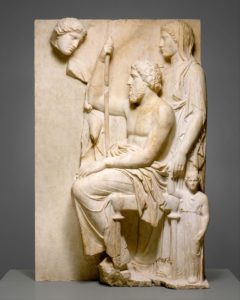
Next, we will look at Marble grave stele with a family group, ca. 360 B.C., Late Classical at the Metropolitan Museum. I brought you to this piece in particular so that we could observe a few details in this piece. In this marble grave stele we can take note of the two women and man, and the chid holding hands with who we could assume is her mother. I chose to show this piece because just like the previous sculpture, we can see a clear representation of a child, this time a little girl. At this point we can see through examining the child that the depiction of Humanism has begun to evolve. One observation we can take into account is the use of size to show that she is in fact representing a young girl. The mother’s hand that is holding the young girl’s hand is noticeably larger than the young girl’s. I would like to point this out because it looks slightly exaggerated, but it can be assumed this was done to show that this a very young child, perhaps between the ages of 5-8. Then, when we take a look at the young girl’s face it is hard to decipher her age range, and if the body were to be gone such as the case with the woman to the left of her, one could argue that it would be difficult to tell that she was a little girl. The size of the head could signify that she was supposed to be a young girl, but the facial features could make one weary. This is why I chose this piece, size is used to clearly depict a child in this family, but the facial features are similar to those of pieces of artwork depicting women. The child has softer features to show a child, but the overall face is still similar to a woman’s. This piece shows evolution in Humanism through the young girl, but there is still an ongoing use of adult-like features on young children at this point in time.
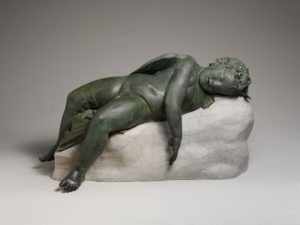
One other piece we will be observing and examining briefly is Bronze statue of Eros sleeping, 3rd-2nd century B.C., Hellenistic Period at the Metropolitan Museum. Even though this piece is representing mythology, we can see obvious evolution of Humanism through Eros being depicted as a child. Brief background for the Hellenistic Period that we are entering is that during Alexander the Great’s reign we see a change and evolution in Humanism. During this time, we begin to see more works of art showcasing different subject matter as well as accurate characterizations of age. On that note, we can really appreciate the details of this piece, which is why I brought you to this piece next. In this piece, even though it is a representation of Eros, we have a child as the main subject matter. In this sculpture we can clearly see many different physical features that are being used to show that this is a child, instead of the reliance on size. Here we see the use of softer lines for Eros’ body in order to give the body a softer and more plush appearance, physical features we expect to see in a child in real life. We even see Eros with chubby feet, again another physical feature that is associated with very young children. Now if we take a look at Eros’ face, the use of soft lines and grooves is used to, again, give the face a softer and rounder look. Also, the tousled curls that Eros has gives him another young boyish feature. I chose this piece because it coincides perfectly with my theme of the evolution of humanism depicted through children. Evolution of Humanism was evident during the Hellenistic Age especially with their true and accurate depictions of children. Here we see more focus on physical features to represent specific age groups instead of the use of size.
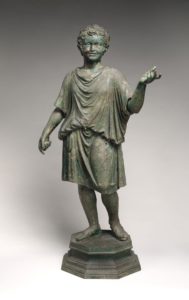
The last picture I will bring your attention to is Bronze statue of a camillus (acolyte), Roman A.D. 14-54, Early Imperial, Julio Claudian at the Metropolitan Museum. As time went on the Romans also began to use more children as subject matter, and there was a focus on physical features depicting accurate age. When taking a look back to the previous pieces and now to this one, we can really begin to appreciate the development of Humanism as time went on. Just like the previous piece, in this Roman sculpture we can appreciate the accurate child-like physical features of this young boy. Here, soft lines and grooves are used for his physical features to once again show that he is a young boy. Although his hair isn’t tousled like Eros, it is cropped, but boyish curls are still depicted giving this child a more youthful look. When looking at his face, we see another depiction of a round and soft face to show the youthfulness of this boy, something we associate with children. We also see a slight smile and the softness of the apples of his cheeks, a physical feature that is prominent amongst children. I wanted to point out this physical feature on the boy because it is one of the most child-like physical features to the point where we have a saying “…so cute I could pinch your cheeks”, which is most often said to children; and the Romans captured this so perfectly. We also see his body as having the correct ratios and proportions to that of a real human child. I believe that this was a good sculpture to close on because we can see through this statue that as civilizations evolved we begin to see the evolution in their detailing to accurately portray the human world. This piece helps to further the idea that children accurately display the development of Humanism throughout the Ancient worlds that we have explored and previous learned about in detail.
I would like to end this tour with some final thoughts about the explored theme and pieces of art works that we examined. In the beginning I proposed to you the idea that while men and women are mostly used to show the development of Humanism throughout the Ancient Worlds, children in artworks accurately show the evolution and development of Humanism. Throughout the different pieces that I showed we begin to see artistic development along with civilization development. In beginning with the piece Statue of Queen Ankhnes-myre II and her son, Pepy II, and then examining the other pieces we can truly appreciate the development of artist’s attention to physical features when it comes to the depiction of children; size is no longer the main detail used to depict children. We began to see the use of softer lines and grooves and accurate proportions in order to accurately represent children in the art world, and their classic physical features that make a viewer instantly assume that a child is being shown. The children in artworks perfectly show the development and evolution of Humanism in the art world.
Works Cited
“Bronze Statue of Eros Sleeping.” Khan Academy, Khan Academy, www.khanacademy.org/humanities/ancient-art-civilizations/greek-art/hellenistic/v/enamored.
Hemingway, Colette, and Seán Hemingway. “The Art of Classical Greece (ca. 480–323 B.C.).” In Heilbrunn Timeline of Art History. New York: The Metropolitan Museum of Art, 2000–. http://www.metmuseum.org/toah/hd/tacg/hd_tacg.htm (January 2008)
Hemingway, Colette, and Seán Hemingway. “Art of the Hellenistic Age and the Hellenistic Tradition.” In Heilbrunn Timeline of Art History. New York: The Metropolitan Museum of Art, 2000–. http://www.metmuseum.org/toah/hd/haht/hd_haht.htm (April 2007)
Nichols, Marden. “Contexts for the Display of Statues in Classical Antiquity.” In Heilbrunn Timeline of Art History. New York: The Metropolitan Museum of Art, 2000–. http://www.metmuseum.org/toah/hd/disp/hd_disp.htm (April 2010)


